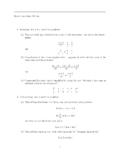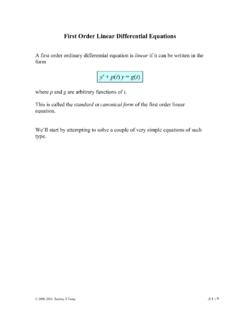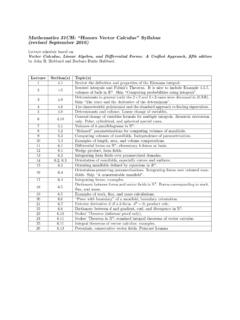Transcription of The Existence and Uniqueness Theorem (of the solution a ...
1 2008, 2012 Zachary S Tseng A 1 24 The Existence and Uniqueness Theorem (of the solution a first order linear equation initial value problem ) Does an initial value problem always a solution ? How many solutions are there? The following Theorem states a precise condition under which exactly one solution would always exist for a given initial value problem . Theorem : If the functions p and g are continuous on the interval I: < t < containing the point t = t0, then there exists a unique function y = (t) that satisfies the differential equation y + p(t) y = g(t) for each t in I, and that also satisfies the initial condition y(t0) = y0, where y0 is an arbitrary prescribed initial value .
2 That is, the Theorem guarantees that the given initial value problem will always have ( Existence of) exactly one ( Uniqueness ) solution , on any interval containing t0 as long as both p(t) and g(t) are continuous on the same interval. The largest of such intervals is called the interval of validity of the given initial value problem . In other words, the interval of validity is the largest interval such that (1) it contains t0, and (2) it does not contain any discontinuity of p(t) nor g(t). Conversely, neither Existence nor Uniqueness of a solution is guaranteed at a discontinuity of either p(t) or g(t).
3 Note that, unless t0 is actually a discontinuity of either p(t) or g(t), there always exists a non empty interval of validity. If, however, t0 is indeed a discontinuity of either p(t) or g(t), then the interval of validity will be empty. Clearly, in such a case the conditions that the interval must contain t0 and that it must not contain a discontinuity of p(t) or g(t) will be contradicting. 2008, 2012 Zachary S Tseng A 1 25 If so, such an initial value problem is not guaranteed to have a unique solution at all. Example: Consider the initial value problem solved earlier cos(t) y sin(t) y = 3t cos(t), y(2 ) = 0.
4 The standard form of the equation is y tan(t) y = 3t with p(t) = tan(t) and g(t) = 3t. While g(t) is always continuous, p(t) has discontinuities at t = /2, 3 /2, 5 /2, 7 /2, .. According to the Existence and Uniqueness Theorem , therefore, a continuous and differentiable solution of this initial value problem is guaranteed to exist uniquely on any interval containing t0 = 2 but not containing any of the discontinuities. The largest such intervals is (3 /2, 5 /2). It is the interval of validity of this problem . Indeed, the actual solution y(t) = 3t tan(t) + 3 3sec(t) is defined everywhere within this interval, but not at either of its endpoints.
5 2008, 2012 Zachary S Tseng A 1 26 How to find the interval of validity For an initial value problem of a first order linear equation, the interval of validity, if exists, can be found using this following simple procedure. Given: y + p(t) y = g(t), y(t0) = y0. 1. Draw the number line (which is the t axis). 2. Find all the discontinuities of p(t), and the discontinuities of g(t). Mark them off on the number line. 3. Locate on the number line the initial time t0. Look for the longest interval that contains t0, but contains no discontinuities. Step 1: Draw the t axis. Step 2: Mark off the discontinuities.
6 Step 3: Locate t0 and determine the interval of validity. 2008, 2012 Zachary S Tseng A 1 27 Example: Consider the initial value problems (a) (t2 81) y + 5e3t y = sin(t), y(1) = 10 (b) (t2 81) y + 5e3t y = sin(t), y(10 ) = 1 The equation is first order linear , so the Theorem applies. The standard form of the equation is 81)sin(815223 = + ttyteyt with 815)(23 =tetpt and 81)sin()(2 =tttg. Both have discontinuities at t = 9. Hence, any interval such that a solution is guaranteed to exist uniquely must contain the initial time t0 but not contain either of the points 9 and 9.
7 In (a), t0 = 1, so the interval contains 1 but not 9. The largest such interval is ( 9, 9). In (b), t0 = 10 , so the interval contains 10 but neither of 9. The largest such interval is (9, ). Remember that the value of y0 does not matter at all, t0 alone determines the interval. Suppose the initial condition is y( 100) = 5 instead. Then the largest interval on which the initial value problem s solution is guaranteed to exist uniquely will be ( , 9). Lastly, suppose the initial condition is y( 9) = 88. Then we would not be assured of a unique solution at all. Since t = 9 is both t0 and a discontinuity of p(t) and g(t).
8 The interval of validity would be, therefore, empty. 2008, 2012 Zachary S Tseng A 1 28 Depending on the problem , the interval of validity, if exists, could be as large as the entire real line, or arbitrarily small in length. The following example is an initial value problem that has a very short interval of validity for its unique solution . Example: Consider the initial value problems (t2 10 2000000) y + t y = 0, y(0) = . With the standard form 010'20000002= ytty, the discontinuities (of p(t)) are t = 10 1000000. The initial time is t0 = 0. Therefore, the interval of validity for its solution is the interval ( 10 1000000, 10 1000000), an interval of length 2 10 1000000 units!
9 However, the important thing is that somewhere on the t axis a unique solution to this initial value problem exists. Different initial value will give different particular solution . But the solution will each uniquely exist, at a minimum, on the interval ( 10 1000000, 10 1000000). Again, according to the Theorem , the only time that a unique solution is not guaranteed to exist anywhere is whenever the initial time t0 just happens to be a discontinuity of either p(t) or g(t). Now suppose the initial condition is y(0) = 0. It should be fairly easy to see that the constant zero function y(t) = 0 is a solution of the initial value problem .
10 It is of course the unique solution of this initial value problem . Notice that this solution exists for all values of t, not just inside the interval ( 10 1000000, 10 1000000). It exists even at discontinuities of p(t). This illustrates that, while outside of the interval of validity there is no guarantee that a solution would exist or be unique, the Theorem nevertheless does not prevent a solution to exist, even uniquely, where the condition required by the Theorem is not met. 2008, 2012 Zachary S Tseng A 1 29 Nonlinear equations : Existence and Uniqueness of Solutions A Theorem analogous to the previous exists for general first order ODEs.













